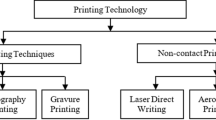Abstract
An analysis is made of the print-quality characteristics of multi-copy printing in which a rigid type font indents several layers of paper and carbon paper resting on a rigid platen. Particular attention is given to determining the contact-pressure distributions for two indenter shapes and for layers of various thicknesses. Stress distributions in the layers are computed and, using a stress-failure mechanism for solid ink, the stress distributions are found to agree well with opticalprint density and reflectance measurements obtained from experiments.
Similar content being viewed by others
Abbreviations
- a :
-
half-width of indenter
- c :
-
length defined in Fig. 3
- h :
-
thickness of layer
- k :
-
number of ink grains
- p :
-
pressure
- r :
-
radius of circular indenter
- t :
-
length of indenter
- v :
-
displacement normal to layer
- x, y :
-
coordinate axes (Figs. 3 and 4)
- A eff :
-
effective area covered by grains [eq (7)]
- A 0 :
-
projected area of ink grain
- A 1 :
-
area of paper on which ink grains deposited
- D a :
-
density defined in eq (10)
- D b :
-
base density defined in eq (6)
- D s :
-
saturation density of ink (Fig. 6)
- I 0 :
-
incident light
- I b :
-
absorbed light
- P :
-
load
- R :
-
optical reflectance [eq (16)]
- S 11,S 22,S 12,S 66 :
-
moduli of elasticity [eq (3)]
- β1,β2 :
-
ratios of elastic constants [eq (2)]
- γ:
-
shear strain
- ɛ:
-
direct strain
- η:
-
x/h
- ζ:
-
y/h
- σ:
-
normal stress
- \(\bar \sigma _e \) :
-
normalized stress [eq (15)]
- σ1 :
-
fracture strength of ink
- τ:
-
shearing stress
References
Conway, H. D., “The Indentation of an Orthotropic Half Plane,”Jnl. Appl. Math. and Phys. (ZAMP),6,402 (1955).
Timoshenko, S., and Goodier, J. N., “Theory of Elasticity,” McGraw Hill Book Co., Inc., 96, 1951.
,404,.
Conway, H. D., “The Pressure Distribution Between Two Elastic Bodies in Contact,”Jnl. Appl. Math. and Phys. (ZAMP),7,463 (1956).
Graf, S. E., Eige, J. J., and Novikoff, A. B., “An Investigation of Impact Printing: Instrumentation Development,” Stanford Rsch. Inst., Proj. No. 2672, October, 1959.
Derr, A. J., “Application of the Microdensitometer To Photo Data Assessment,” 5th An. Tech. Symp., Soc. of Photo. Instr. Engrs., Aug. 1–4, 1960.
Conway, H. D., “Further Problems of Orthotropic Plane Stress,”Trans. ASME,7,260 (1955).
“Tables of Sine and Cosine Integrals,” W.P.A. Project, 1942.
Author information
Authors and Affiliations
Rights and permissions
About this article
Cite this article
Conway, H.D., Schaffer, R.R. The contact problem in solid-ink printing. Experimental Mechanics 7, 15–22 (1967). https://doi.org/10.1007/BF02326835
Issue Date:
DOI: https://doi.org/10.1007/BF02326835




